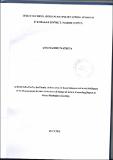| dc.description.abstract | According to the World Drug Report, the use of illicit substances has increased throughout the world in recent years. The report further stated that a major world trend is the increasing availability of many kinds of substances to an ever widening socio-economic spectrum of consumers. For example, for most of Europe and Asia, opiates continued to be the main problem drugs, accounting for 62 percent of all treatment in 2003. Reports from a total of 95 countries indicated that drug seizures increased four-fold in 2003, and more than half of these were of cannabis. The overall objective of this study was to find out the impact of substance abuse on the academic performance of secondary school students in Embakasi district, Nairobi County. The proposed study could help the Ministry of Education (M.0.E.) to better understand the current situation and accordingly make changes to address the factors that contribute to substance abuse in secondary schools. The research design for this study was a descriptive survey. The target population for this study was Forms 3 and 4 students, deputy-head teachers, school counselors, class teachers and parents. Forms 3 and 4 students were selected because they have been in school for some time and are likely to be more familiar with the cases of drug abuse in schools and better placed to evaluate the impact of these substances on the academic performance of students. Only nine of the 28 secondary schools in Embakasi District were utilized for this study. The main research instruments that were used to collect data in a survey are questionnaires and interviews. Data was analyzed quantitatively and qualitatively. The empirical study showed that drug abuse is widespread among students, with majority of students saying they have abused drugs other than for medicinal purposes
. The study concludes Drug abuse among students is common and spells danger not only to the youth who abuse the drugs but also to the well-being of the nation, because the youth represent the future of its people. The study recommended that any education programme aimed at addressing drug abuse among students should be holistic and address both the risk and protective factors. The aim should be to strengthen the protective factors where potential buffers include strong family bonding, school commitment, positive role models and a strong belief in one's own efficacy. | en_US |

